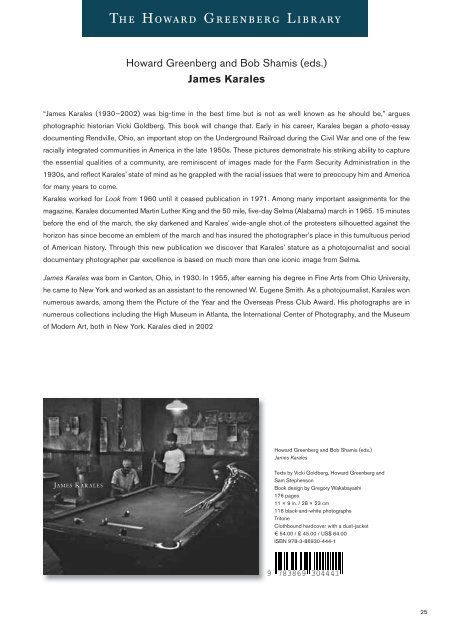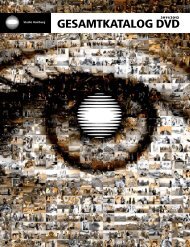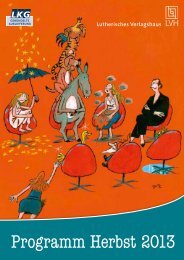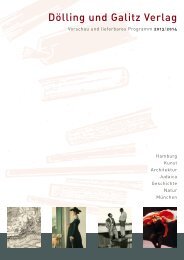SPRING/SUMMER 2014 - boersenblatt.net
SPRING/SUMMER 2014 - boersenblatt.net
SPRING/SUMMER 2014 - boersenblatt.net
Create successful ePaper yourself
Turn your PDF publications into a flip-book with our unique Google optimized e-Paper software.
The Howard Greenberg Library<br />
Howard Greenberg and Bob Shamis (eds.)<br />
James Karales<br />
“James Karales (1930–2002) was big-time in the best time but is not as well known as he should be,” argues<br />
photographic historian Vicki Goldberg. This book will change that. Early in his career, Karales began a photo-essay<br />
documenting Rendville, Ohio, an important stop on the Underground Railroad during the Civil War and one of the few<br />
racially integrated communities in America in the late 1950s. These pictures demonstrate his striking ability to capture<br />
the essential qualities of a community, are reminiscent of images made for the Farm Security Administration in the<br />
1930s, and reflect Karales’ state of mind as he grappled with the racial issues that were to preoccupy him and America<br />
for many years to come.<br />
Karales worked for Look from 1960 until it ceased publication in 1971. Among many important assignments for the<br />
magazine, Karales documented Martin Luther King and the 50 mile, five-day Selma (Alabama) march in 1965. 15 minutes<br />
before the end of the march, the sky darkened and Karales’ wide-angle shot of the protesters silhouetted against the<br />
horizon has since become an emblem of the march and has insured the photographer’s place in this tumultuous period<br />
of American history. Through this new publication we discover that Karales’ stature as a photojournalist and social<br />
documentary photographer par excellence is based on much more than one iconic image from Selma.<br />
James Karales was born in Canton, Ohio, in 1930. In 1955, after earning his degree in Fine Arts from Ohio University,<br />
he came to New York and worked as an assistant to the renowned W. Eugene Smith. As a photojournalist, Karales won<br />
numerous awards, among them the Picture of the Year and the Overseas Press Club Award. His photographs are in<br />
numerous collections including the High Museum in Atlanta, the International Center of Photography, and the Museum<br />
of Modern Art, both in New York. Karales died in 2002<br />
Howard Greenberg and Bob Shamis (eds.)<br />
James Karales<br />
JAMES KARALES<br />
Texts by Vicki Goldberg, Howard Greenberg and<br />
Sam Stephenson<br />
Book design by Gregory Wakabayashi<br />
176 pages<br />
11 × 9 in. / 28 × 23 cm<br />
116 black-and-white photographs<br />
Tritone<br />
Clothbound hardcover with a dust-jacket<br />
€ 54.00 / £ 45.00 / US$ 64.00<br />
ISBN 978-3-86930-444-1<br />
25
















